Relationship between the Intermediate Soil State and Settlement Control Measures during Tunnel Construction Undercrossing the Existing Station
Abstract
:1. Introduction
2. Case Investigation of Underground Tunnels Crossing Existing Stations
2.1. Case Analysis
2.2. Settlement Characteristics of Existing Stations
- (1)
- Settlement of existing stations under the action of jack and grouting jacking
- (2)
- Settlement of the existing station under the passive reinforcement of intermediate soil
3. Influence of Intermediate Soil Damage on the Settlement of Existing Stations
3.1. Computation Module
3.2. Influence of Intermediate Soil Thickness on the Settlement of Existing Stations
3.3. Influence of Mechanical Parameters of Intermediate Soil on the Settlement of Existing Stations
- (1)
- Effect of soil elastic modulus on the settlement of existing stations
- (2)
- Effect of soil cohesion on the settlement at existing stations
- (3)
- Effect of soil friction angle on the settlement of existing stations
3.4. Influence of Excavation Span of the Underground Tunnel on the Settlement of Existing Station
3.5. Influence of Buried Depth of Station on Settlement of Existing Station
4. Intermediate Soil Damage Identification Method
4.1. Relationship between Failure Mode of the Intermediate Soil and the Reinforcement Method
4.2. Intermediate Soil Mechanics Model
4.3. Intermediate Soil Failure Criterion
5. Engineering Case Analysis
6. Conclusions
- (1)
- The settlement control measures for existing stations in tunnel construction are of two main types: compensation jacking and passive reinforcement of the soil. Jacking compensates for the settlement deformation of an existing structure by applying a jacking force, and the settlement of the existing structure changes inversely. The reinforcement of the soil improves the bearing capacity of the intermediate soil, thereby reducing the settlement of the existing structure.
- (2)
- The settlement control measures of the existing station are closely related to the thickness of the intermediate soil and span of the tunnel excavation, which determine the bearing capacity of the intermediate soil. Thinner and longer intermediate soils have a weaker bearing capacity. Strong reinforcement measures such as compensation jacking are often used in construction. In contrast, soil reinforcement measures are often used to improve the bearing capacity of intermediate soil and control the settlement deformation of existing stations.
- (3)
- The numerical simulation showed that the failure mode of the intermediate soil was divided into two modes: complete and partial failures. The failure state of intermediate soil should be considered in the formulation of settlement control measures for existing stations.
- (4)
- The thickness of the intermediate soil, mechanical parameters of the soil, span of the new excavation, and buried depth of the existing station affected the stress state of the intermediate soil. A simple discriminant model for the failure of intermediate soils was proposed. Compensation jacking measures should be implemented to control the settlement of the existing structures during construction when the intermediate soil is completely destroyed. Passive soil reinforcement measures should be implemented when the intermediate soil is partially destroyed. The discriminant model can guide the formulation of settlement control measures for the existing stations.
- (5)
- In this study, some simplifications were made when formulating the intermediate soil mechanics model without considering the characteristics of the stratum, which has certain limitations. Differences were observed in the failure modes of the intermediate soil between sandy and cohesive soils. Subsequent studies should combine the characteristics of the strata to develop a more realistic stress model.
Author Contributions
Funding
Data Availability Statement
Conflicts of Interest
Appendix A
| New Built Tunnel | Existing Station | Intermediate Soil Thickness | Buried Depth of Existing Station | Excavation Span | Stratum | Measure | Construction Method | Sedimentation |
|---|---|---|---|---|---|---|---|---|
| Xuan wu men Station of Line 4 | Xuan wu men Station of Line 2 | 1.9 | 4.5 | 9.85 | Pebble gravel layer, silty clay layer, silt layer | Pipe roof | CRD method | 3.45 |
| Ping guo yuan Station of Beijing Subway Line 6 | Ping guo yuan Station of Beijing Metro Line 1 | 0 | 6.7 | 23.5 | Pebble bed | Screw + grouting jacking | PBA method | 1.909 |
| Su zhou Street Station of Beijing Line 16 | Su zhou Street Station of Metro Line 10 | 0 | 6.3 | 27.6 | Artificial fill soil and Quaternary sedimentary clay, silt, sand, gravel soil | Lifting jack | PBA method | 2.07 |
| Chaoyangmen Station-Dongdaqiao Station interval of Metro Line 6 | Chaoyangmen Station of Line 2 | 0 | 5.22 | 22.7 | Round gravel pebble and silty clay layer | Lifting jack | CRD construction method of flat top straight wall | 2.5 |
| Line 16 national library station to Erligou station interval | Line 4 National Library~Zoo interval right line | 3.368 | 14.896 | 6.30 | Fine sand layer, pebble layer | Grouting reinforcement | Bench cut method | 1.88 |
| Gongzhufen Station of Beijing Metro Line 10 | Gongzhufen Station of Beijing Metro Line 1 | 0 | 5.4 | 26.1 | Conglomerate layer, local mudstone, pebble layer | Lifting jack | CRD method | 2.98 |
| Chongwenmen Station of Line 5 | Line 2 Chongwenmen~Beijing Station interval | 1.98 | 5.16 | 24.2 | Silty sand stratum | Pipe shed + grouting jacking | Column–hole method | 16.75 |
| Line 6 Dongsi~Chaoyangmen interval | Line 5 Dongsi station | 0 | 12.7 | 33.8 | Silty fine sand layer and medium coarse sand layer | Lifting jack | CRD method | 2.35 |
| Line 7 Guangqumenwai station to Shuangjing station interval | Shuangjing Station of Line 10 | 0 | 13.7 | 23.1 | Interbedding of confined water-rich sand | Lifting jack | CRD method | 1.2 |
| Chongwen Sanlihe Station—Ciqikou Station Section East Side of Beijing Subway Line 7 | Ciqikou Station of Line 5 | 0.7 | 10.1 | 35.3 | Pebble, medium-coarse sand, silty clay, and silt | Pipe roof | Bench cut method | 3 |
| Line 6 Chegongzhuang~Ping ‘anli interval | Chegongzhuang Station of Line 2 | 2.47 | 4.7 | 6.6 | Clay, silt | Grouting reinforcement | bench cut method | 3.08 |
| Line 14 Anlelin~Puhuangyu interval | Puhuangyu Station of Line 5 | 0.35 | 5.85 | 6.6 | Sandy cobble ground | Grouting jacking up | CRD method | 1.5 |
| Beijing Metro Line 17 Shilihe Station~Panjiayuan West Station Section | The existing Shilihe Station of Beijing Metro Line 14 | 2.79 | 4.5 | 6.48 | Water-rich sand stratum | Grouting reinforcement | CRD method | 2.38 |
| Tuanjiehu Station-Chaoyang Park Station Section of Beijing Subway Line 3 | Tuanjiehu transfer station of Line 10 | 0 | 9 | 6.75 | Conglomerate strata | Lifting jack | CRD method | 4.89 |
| Shenzhen Metro Line 10 Futian Port Station~Fumin Station Section | Futian Port Station of Line 4 | 9.7 | 8.48 | Gravel sand, pebble soil, sandy strongly weathered granite, moderately weathered granite, slightly weathered granite, gravel sand layer above with coarse sand, muddy clay | Pipe roof | CRD method | 1.98 | |
| Zhongsheng Station of Nanjing Metro Line 7 | Existing Zhongsheng Station of Line 10 | 0.6 | 3.2 | 9 | Confined water-rich sand layer | Freezing reinforcement | 6.97 | |
| Chengmen Station of Fuzhou Metro Line 4 | Existing Line 1 station | 0 | 8.8 | 6.8 | Muddy soil, residual cohesive soil, complete weathering | Freezing reinforcement | CRD method | 3.6 |
| Dongdaqiao Station of Metro Line 17 | No. 6 subway line east bridge station | 2.1 | 9.9 | Pipe roof | PBA method | 2.02 | ||
| Hefei Metro Line 8 | Yilijing Station of Line 3 | 2.07 | 4.3 | Medium weathered sandstone | Grouting reinforcement | Bench cut method | 2.39 | |
| Chengdu Metro Nijiaqiao Station New Line 8 | Existing Metro Line 1 Station | 0 | 2 | 23.4 | Medium dense pebble soil layer, strongly weathered mudstone | Lifting jack | CRD method | 4.84 |
| Tianfu Business District Station of Chengdu Metro Line 19 | Tianfu Business District Station of Chengdu Metro Line 6 | 0 | 4 | 28.6 | Middle weathered mudstone strata | Temporary support | Bench cut method | 4.6 |
| Zhengzhou Metro Line 4 Exhibition Center Station | Line 1 exhibition Central station | 0 | 6 | 23.7 | Silt–sand layer | Sleeve lift | Bench cut method | 2.2 |
| Xinjianciqu Station of Beijing Metro Line 17 | Yizhuang line Ciqu station | 0 | 3 | 9.5 | Sandy silt and silty clay, locally sandwiched thin layer of clayey silt | PBA method | ||
| Xuzhou City Line 6 | Line 2 municipal government station | 0 | 5.6 | 6.41 | Sandy silt layer | Pipe roof + grouting reinforcement | CRD method | |
| Chengdu Metro Line 9 Tunnel | Incubation Park Station of Chengdu Metro Line 1 | 2.3 | 4.1 | 8.5 | Pebble soil, strongly weathered mudstone | Pipe roof | CRD method | 4 |
| Hefei Rail Transit Line 7 | Zilu Station of Line 1 | 0 | 3.1 | 14 | Clay and silty clay layer, no sand layer or other permeable layer | Pipe roof | CRD method | 2.2 |
| Beijing rail transit capital airport line west extension project Dongzhimen station to Beixinqiao station interval | Dongzhimen station of existing M2 line | 0 | 8.8 | 9.6 | Lifting jack | PBA method | 4.8 | |
| Yungu Road Station-Huashan Station of Hefei Rail Transit Line 5 | existing station | 1.9888 | 8.2 | Weak expansion potential clay layer | Grouting reinforcement | CRD method | 7 | |
| Shenyang New Line 9 | Line 1 Shenyang Tiexi Square Station | 0 | 3.48 | 12.9 | 3.3 | |||
| Chongqing North Railway Station | Existing Line 3 station | 7.2 | 1.5 | 15 | Filling, sandy mudstone, sandstone | Pipe roof | Bench cut method | 1.75 |
| Guomao Station-Shuangjing Station Section of Beijing Subway Line 10 | Existing Line 1 | 1.2 | 12.3 | 8.2 | Sandy cobble ground | Steel support | CRD method | 4.77 |
| A new subway in Hangzhou | existing station | 0 | 3.1 | 6.94 | Muddy silty clay, silty clay | Mjs reinforcement + lifting jack | CRD method | 6 |
| Beijing metro line 19 interval | Xingong Station of Line 4 | 0.22 | 3.2 | 13.5 | Pebble gravel stratum | Full framing | CRD method | 3 |
| Shenzhen Metro Line 7 | Fumin Station of Line 4 | 0 | 3.6 | 6.6 | Gravel cohesive soil, sandy soil | Grouting jacking up | CRD method | 2.03 |
| Guoquan Road Station-Fudan University Station Section of Shanghai Rail Transit Line 18 | Rail transit line 10 Guoquan Road station | 2 | 7.7 | Clay, silty clay, water-rich | Freezing reinforcement | Mining method | 8.4 | |
| Beijing rail transit capital airport line | Beixin Bridge of Line 5Station | 0 | 3.3 | 11.9 | Silty clay, fine sand, pebble layer | Grouting jacking up | PBA method | 5.1 |
| Chengdu Line 5, Sichuan Province | Provincial People ‘s Hospital Station of University of Traditional Chinese Medicine | 0 | 6.8 | Dense sand pebble layer | CRD method | |||
| Baoan District Reclamation Area Line 1 Project | Sanhaojie Station of Line 5 | 8.16 | Residual cohesive soil, granite completely strong weathering level in weathering | Grouting reinforcement | Bench cut method | 6.2 | ||
| Intermediate Station of Chengdu Rail Transit Line 13 Phase I Project | Existing stations of Line 7 | 0 | 2.6 | 23.2 | Dense pebble layer | Lifting jack | CRD method | 5.2 |
| Metro Line 9 Olympic Sports Center Station~Olympic Sports East Station | Existing Line 2 Olympic Sports Center Station | 0 | 3.5 | 20.5 | Miscellaneous fill, silty clay, gravel sand, round gravel | Lifting jack | Bench cut method | 2.43 |
| Shanghai Road Station of Nanjing Metro Line 5 | Shanghai Road Station of existing Metro Line 2 | 0 | 2.3 | 13 | Silty clay mixed with silt, pebble-containing silty clay and strong and medium weathered glutenite | Lifting jack | Bench cut method | 2.9 |
| Kunming new subway line 4 Liandajie station-Kunming south railway station interval | Liandajie Station of Kunming Metro Line 1 | 2 | Clay, silty clay layer | Grouting reinforcement | CRD method | 6 | ||
| Shanghai S line subway | existing station | 0 | 3.5 | Silty clay layer | Lifting jack | PBA method | 2.35 | |
| South-to-North Water Diversion culvert | Wukesong Station of Line 1 | 3.667 | 4.83 | 4.2 | silty fine sand, boulder flint | Grouting reinforcement | Bench cut method | 4.83 |
| Park Front Station of Guangzhou Metro Line 2 | Existing Line 1 station | 0 | 1 | Miscellaneous fill, silty clay, strong, medium and slightly weathered bedrock (siltstone with pebbly sandstone) | Horizontal beam plate and steel pipe connection | Cover-excavation inverse construction method | 13.8 | |
| Satellite Square Station of Changchun Metro Line 1 | Light rail line 3 project | 0 | 5 | 21.7 | Miscellaneous fill, silty clay, clay, weathered mudstone | Lifting jack | PBA method | 9.5 |
| Beijing Road Station of Guiyang Metro Line 3 | rail transit line 1 | 0 | 0 | 15.5 | Miscellaneous fill, red clay, Triassic Anshun Formation dolomite | Steel cylindrical column | Arch cover pillar method | |
| Qianhaiwan Station-Bao‘an Station Section of Shenzhen Rail Transit Line 11 Project | Baohua Station on Line 5 | 8.16 | 3.35 | Residual cohesive soil, granite fully strong weathered layer and medium weathered, slightly weathered zone | Grouting reinforcement | Step method initial support + shield segment | 6.1 | |
| Chongqing Rail Line 10 | Hongtudi Station of Rail Line 6 | 5.06 | 11.54 | Sandy mudstone, sandstone, sandy mudstone strata | Grouting reinforcement | CRD method | 8.42 |
References
- Broere, W. Urban underground space: Solving the problems of today’s cities. Tunn. Undergr. Space Technol. 2016, 55, 245–248. [Google Scholar]
- Addenbrooke, T.I.; Potts, D.M. Twin Tunnel Interaction: Surface and Subsurface Effects. Int. J. Geomech. 2001, 1, 249–271. [Google Scholar]
- Ding, Z.; Zhang, M.-B.; Zhang, X.; Wei, X.-J. Theoretical analysis on the deformation of existing tunnel caused by under-crossing of large-diameter slurry shield considering construction factors. Tunn. Undergr. Space Technol. Inc. Trenchless Technol. Res. 2023, 133, 104913. [Google Scholar] [CrossRef]
- Avgerinos, V.; Potts, D.M.; Standing, J.R. Numerical investigation of the effects of tunnelling on existing tunnels. Géotechnique 2017, 67, 808–822. [Google Scholar] [CrossRef]
- Hou, Y.; Zhang, D.; Chen, F. Study of mechanism and prediction of grouting uplift in tunnel construction undercrossing buildings. Chin. J. Rock Mech. Eng. 2011, 30, 2407–2415. [Google Scholar]
- Lai, H.; Zheng, H.; Chen, R.; Kang, Z.; Liu, Y. Settlement behaviors of existing tunnel caused by obliquely under-crossing shield tunneling in close proximity with small intersection angle. Tunn. Undergr. Space Technol. 2020, 97, 103258. [Google Scholar] [CrossRef]
- Jin, D.; Yuan, D.; Liu, S.; Li, X.; Luo, W. Performance of Existing Subway Tunnels Undercrossed by Four Closely Spaced Shield Tunnels. J. Perform. Constr. Facil. 2019, 33, 04018099. [Google Scholar] [CrossRef]
- Ma, S.; Li, M.; Jin, J.; Bai, K. The influence of shallow buried double-line parallel rectangular pipe jacking construction on ground settlement deformation. Alex. Eng. J. 2021, 60, 1911–1916. [Google Scholar]
- Jia, L. Study on the Effects of New Metro Station Crossing under the Existing Peculiar Metro Station in Small Distance. Ph.D. Thesis, Beijing University of Civil Engineering and Architecture, Beijing, China, 2016. [Google Scholar]
- Li, P.; Du, S.-J.; Ma, X.-F.; Yin, Z.-Y.; Shen, S.-L. Centrifuge investigation into the effect of new shield tunnelling on an existing underlying large-diameter tunnel. Tunn. Undergr. Space Technol. 2014, 42, 59–66. [Google Scholar] [CrossRef]
- Qi, Y.; Wei, G.; Xie, Y. Method of Calculating the Vertical Displacement and Additional Stress of Existing Tunnels under the Influence of Grouting Rings of New Tunnels. Symmetry 2020, 12, 1623. [Google Scholar]
- Wang, H.N.; Gao, X.; Wu, L.; Jiang, M.J. Analytical study on interaction between existing and new tunnels parallel excavated in semi-infinite viscoelastic ground. Comput. Geotech. 2020, 120, 103385. [Google Scholar]
- Gokuldas, S.; Banerjee, S.; Nimbalkar, S.S. Effects of Tunneling-Induced Ground Movements on Stability of Piled Raft Foundation: Three-Dimensional Finite-Element Approach. Int. J. Geomech. 2020, 20, 04020104. [Google Scholar]
- Zhou, L.; Zhu, Y. Analysis of Stratum Settlement Laws Caused by the Construction of Shallow-Buried Expressway Tunnels with Large Span and Small Spacing. Geotech. Geol. Eng. 2021, 39, 1485–1495. [Google Scholar]
- Mirhabibi, A.; Soroush, A. Three-Dimensional Simulation of Interaction between Surface Buildings and Twin Tunnelling Regarding the Surface Settlement. Geotech. Geol. Eng. 2020, 38, 5143–5166. [Google Scholar]
- Yang, H.; Shi, H.; Jiang, X.; Liu, C.; Yu, L. Study on Influence of Construction Process of Double-Line Shield Tunnels on Frame Structure. Geotech. Geol. Eng. 2021, 39, 1465–1484. [Google Scholar] [CrossRef]
- Zhou, F.; Zhou, P.; Li, J.; Lin, J.; Ge, T.; Deng, S.; Ren, R.; Wang, Z. Deformation characteristics and failure evolution process of the existing metro station under unilateral deep excavation. Eng. Fail. Anal. 2022, 131, 105870. [Google Scholar]
- Liang, R.; Xia, T.; Hong, Y.; Yu, F. Effects of above-crossing tunnelling on the existing shield tunnels. Tunn. Undergr. Space Technol. Inc. Trenchless Technol. Res. 2016, 58, 159–176. [Google Scholar]
- Li, Y.; Zhou, G.; Tang, C.; Wang, S.; Wang, K.; Wang, T. Influence of undercrossing tunnel excavation on the settlement of a metro station in Dalian. Bull. Eng. Geol. Environ. 2021, 80, 4673–4687. [Google Scholar] [CrossRef]
- Sharma, J.; Hefny, A.; Zhao, J.; Chan, C. Effect of large excavation on deformation of adjacent MRT tunnels. Tunn. Undergr. Space Technol. Inc. Trenchless Technol. Res. 2001, 16, 93–98. [Google Scholar]
- Zhang, Z.; Huang, M. Geotechnical influence on existing subway tunnels induced by multiline tunneling in Shanghai soft soil. Comput. Geotech. 2014, 56, 121–132. [Google Scholar]
- Lin, Z.; Chen, X.; Yang, H.; Cheng, C.; Wang, H.; Yang, C.; Zhu, G. Experimental Study on Structural Form and Excavation Model of Urban Metro Cross Transfer Station with Super Large Cross Section and Shallow Excavation. Adv. Civ. Eng. 2020, 2020, 9723927. [Google Scholar]
- Fang, Q.; Zhang, D.; Li, Q.; Wong, L.N.Y. Effects of twin tunnels construction beneath existing shield-driven twin tunnels. Tunn. Undergr. Space Technol. Inc. Trenchless Technol. Res. 2015, 45, 128–137. [Google Scholar]
- Ng, C.W.W.; Boonyarak, T.; Mašín, D. Three-dimensional centrifuge and numerical modeling of the interaction between perpendicularly crossing tunnels. Can. Geotech. J. 2013, 50, 935–946. [Google Scholar] [CrossRef]
- Liu, X.; Fang, Q.; Zhang, D. Mechanical responses of existing tunnel due to new tunnelling below without clearance. Tunn. Undergr. Space Technol. 2018, 80, 44–52. [Google Scholar] [CrossRef]
- Liu, X.; Fang, Q.; Zhang, D.; Liu, Y. Energy-based prediction of volume loss ratio and plastic zone dimension of shallow tunnelling. Comput. Geotech. 2020, 118, 103343. [Google Scholar] [CrossRef]
- Li, X.; Zhang, C.; Yuan, D. An in-tunnel jacking above tunnel protection methodology for excavating a tunnel under a tunnel in service. Tunn. Undergr. Space Technol. Inc. Trenchless Technol. Res. 2013, 34, 22–37. [Google Scholar]
- Wu, K.; Shao, Z. Effects of Pipe Roof Support and Grouting Pre-Reinforcement on the Track Settlement. Adv. Civ. Eng. 2018, 2018, 6041305. [Google Scholar]
- Kummerer, C.; Schweiger, H.F.; Otterbein, R. Active Settlement Control with Compensation Grouting—Results from a Case Study. In Proceedings of the International Conference on Grouting & Ground Treatment, New Orleans, LA, USA, 10–12 February 2003; pp. 813–823. [Google Scholar]
- Huo, R.; Zhou, P.; Song, Z.; Wang, J.; Li, S.; Zhang, Y. Study on the settlement of large-span metro station’s baseplate caused by the tunnels newly built beneath it. Adv. Mech. Eng. 2019, 11, 1687814018825161. [Google Scholar] [CrossRef] [Green Version]
- Zhang, X.; Zhang, C.; Wang, J. Effect of Closely Spaced Twin Tunnel Construction beneath an Existing Subway Station: A Case Study. J. Test. Eval. 2018, 46, 1559–1573. [Google Scholar]
- Li, J.; Li, J.; Cai, Y.; Wu, D.; Guo, C.; Zhao, W.; Tang, K.; Liu, Y. Application of Artificial Freezing Method in Deformation Control of Subway Tunnel. Adv. Mater. Sci. Eng. 2022, 2022, 3251318. [Google Scholar]
- Zheng, Y.; Wu, K.; Sun, J.; Chen, R.; Li, Y.; Yang, S. Study on the Influence of Close Distance Construction of Urban Tunnel on the Existing Station. Geotech. Geol. Eng. 2021, 39, 4765–4780. [Google Scholar] [CrossRef]
- Zhao, C.; Lei, M.; Shi, C.; Cao, H.; Yang, W.; Deng, E. Function mechanism and analytical method of a double layer pre-support system for tunnel underneath passing a large-scale underground pipe gallery in water-rich sandy strata: A case study. Tunn. Undergr. Space Technol. 2021, 115, 104041. [Google Scholar]
- Fu, H.; An, P.; Huang, Z.; Zhang, J.; Shi, Y.; Yao, G. Determination of safety distance of twin tunnel underpassing existing tunnels. In Advances in Environmental Vibration and Transportation Geodynamics: Proceedings of ISEV 2018; Springer: Singapore, 2020; pp. 839–848. [Google Scholar]
- Hage Chehade, F.; Shahrour, I. Numerical analysis of the interaction between twin-tunnels: Influence of the relative position and construction procedure. Tunn. Undergr. Space Technol. 2007, 23, 210–214. [Google Scholar]
- Shahin, H.M.; Nakai, T.; Ishii, K.; Iwata, T.; Kuroi, S. Investigation of influence of tunneling on existing building and tunnel: Model tests and numerical simulations. Acta Geotech. 2016, 11, 679–692. [Google Scholar]
- Zhang, X.; Zhang, C.; Han, K.; Wang, J. Case study of control technology of structural settlements due to tunnelling beneath a subway station. Chin. J. Geotech. Eng. 2017, 39, 759–766. [Google Scholar]
- Zhang, Z.; Liu, Z.; Zheng, K. Optimization construction process of PBA new station pilot tunnels under the existing station. Build. Struct. 2020, 50, 882–887. [Google Scholar]
- Zhang, C.; Zhang, D.; Wang, M. Structural deformation of overlying subway tunnels induced by tunnelling. Chin. J. Rock Mech. Eng. 2009, 31, 805–810. [Google Scholar]
- Wang, J.; Li, X.; Wu, S.; He, Z.; Wei, Y. Field test and numerical simulation of ground settlement in super shallow buried station excavation supported by transverse pipe roof. Front. Earth Sci. 2023, 11, 1136270. [Google Scholar]
- Wu, S.; Xie, H.; Zeng, Z.; Wang, M.; Zhao, H.; Liu, Y. Influence of Pea-Gravel Layer on Segment Ring Support Performance in Shield TBM Tunnels: A Discrete-Continuous Coupling Simulation and Model Test. J. Constr. Eng. Manag. 2023, 149, 04023097. [Google Scholar] [CrossRef]
- Liu, X.; Fang, Q.; Zhang, D.; Wang, Z. Behaviour of existing tunnel due to new tunnel construction below. Comput. Geotech. 2019, 110, 71–81. [Google Scholar] [CrossRef]
- Xu, T. Study on Mechanical Evolution and Design Method of Undercut Multi-Ayered Tunnel Groups. Ph.D. Thesis, Southwest Jiaotong University, Chengdu, China, 2019. [Google Scholar] [CrossRef]
- Niu, X. Engineering Response and Control of Existing Tunnel Structure with Long Distance Close Bonding and Parallel Undercrossing. Ph.D. Thesis, Beijing Jiaotong University, Beijing, China, 2018. [Google Scholar]
- Bai, Q.; Zhang, Y.; Zhao, W.; Jia, P.; Li, S.; Wang, Z. Construction of subway station using the small pipe roof-beam method: A case study of Shifu Road station in Shenyang. Tunn. Undergr. Space Technol. 2023, 135, 105000. [Google Scholar]


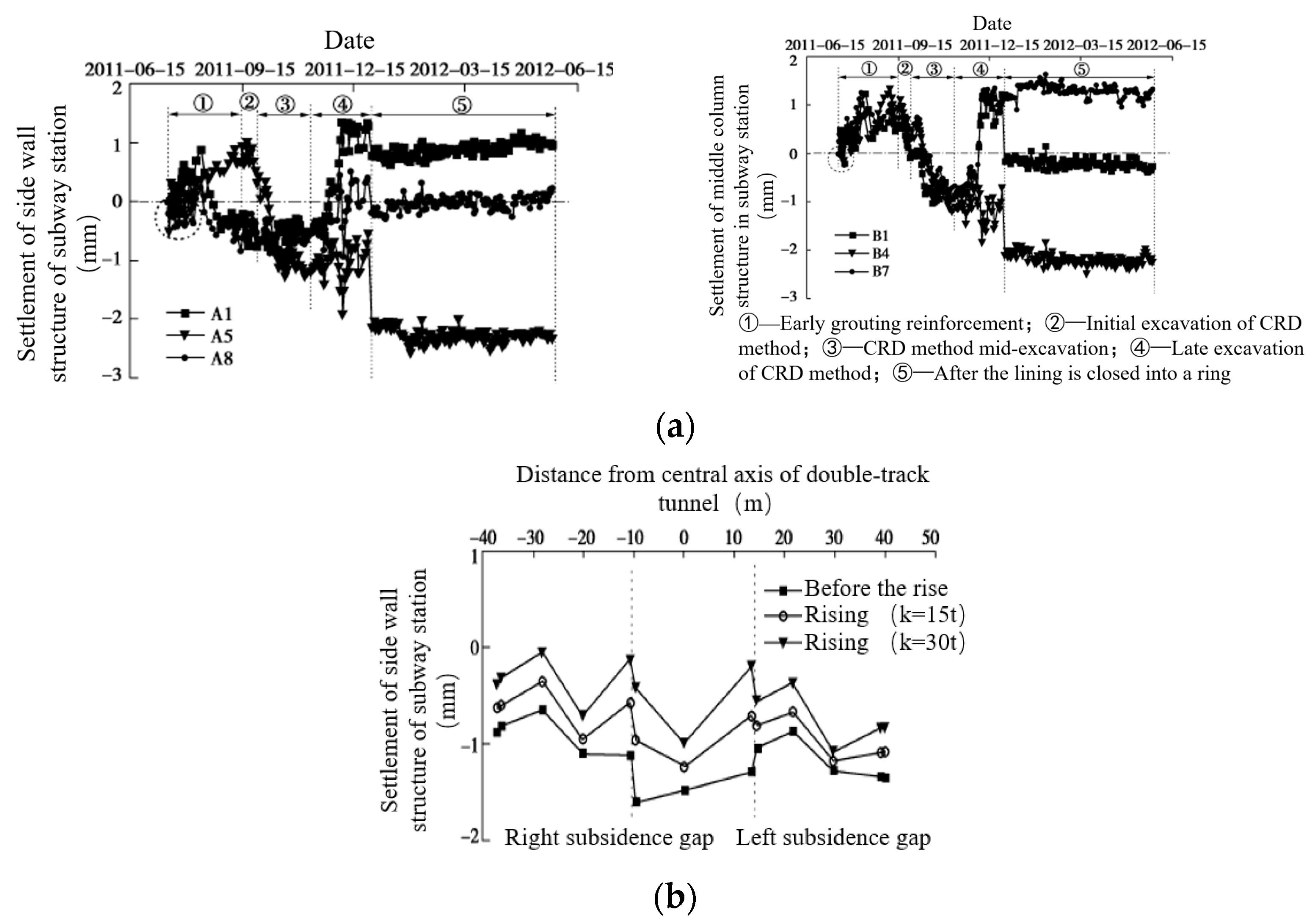
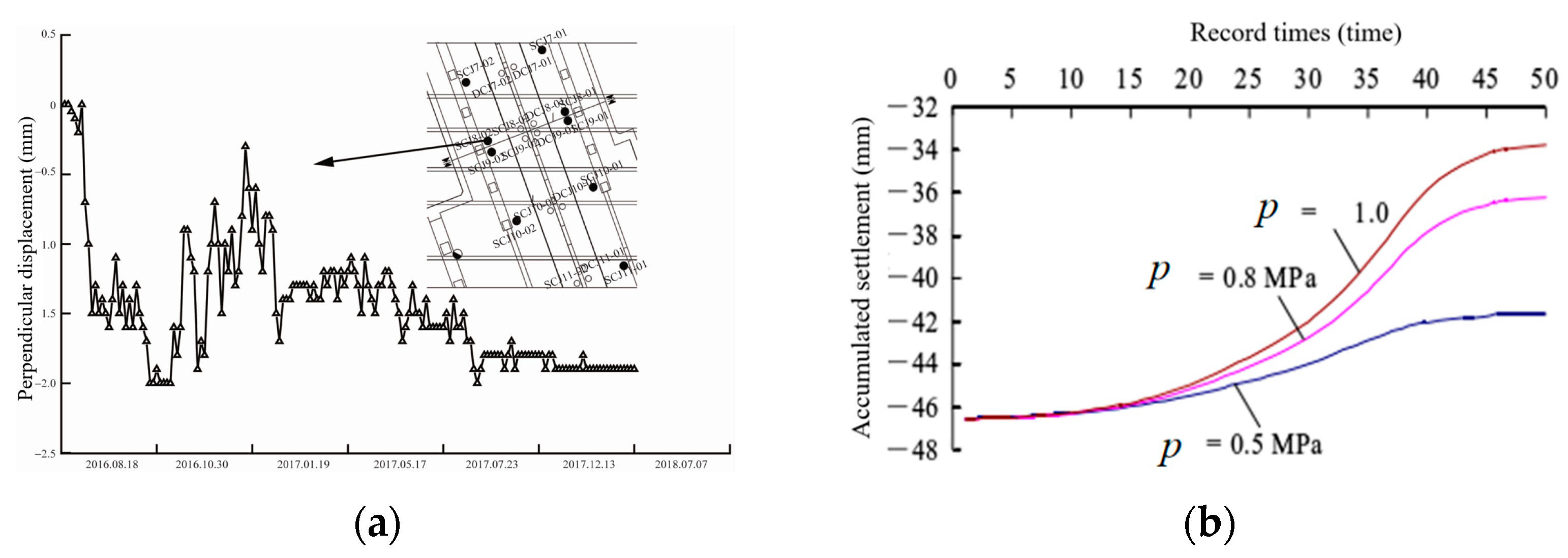
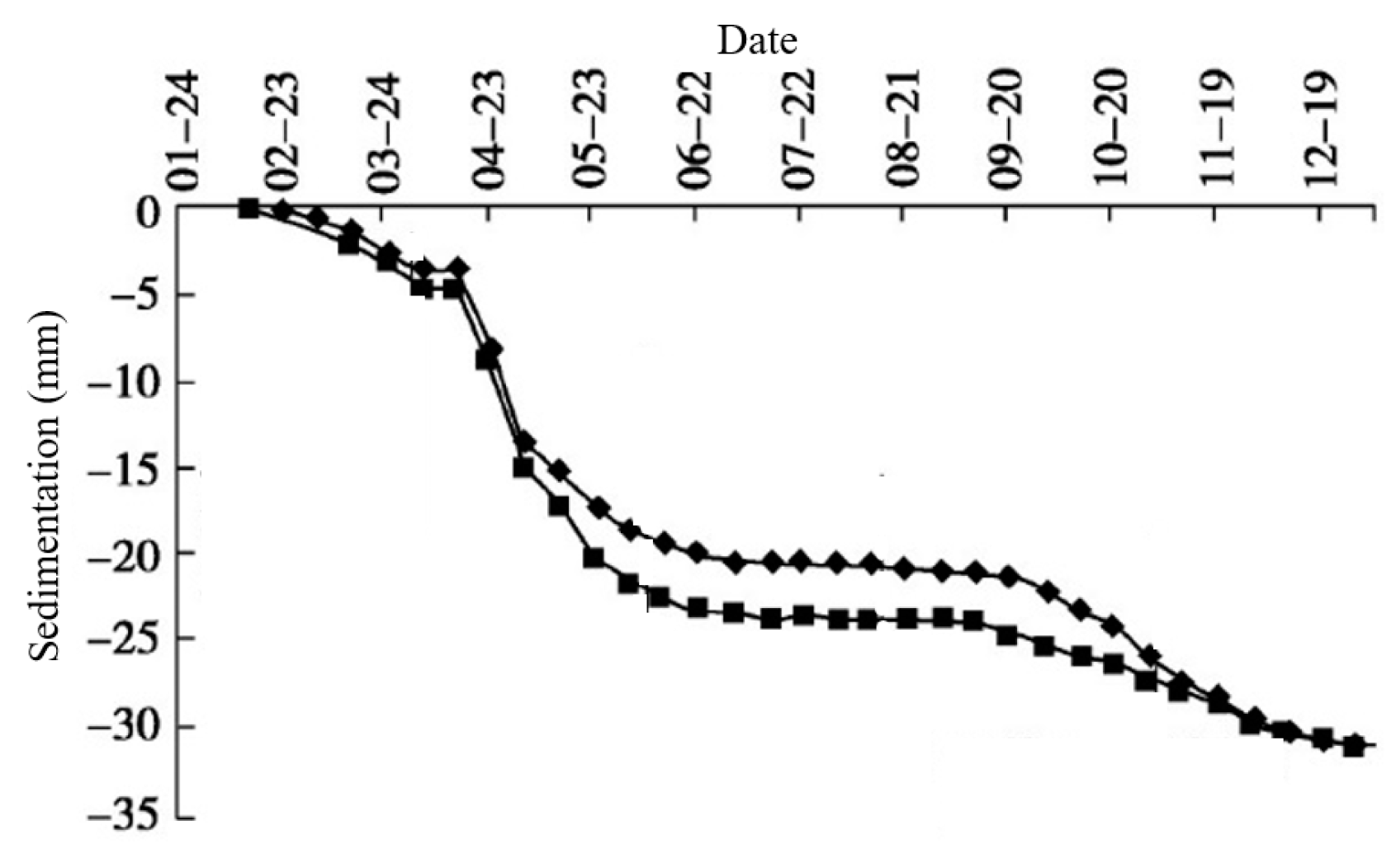

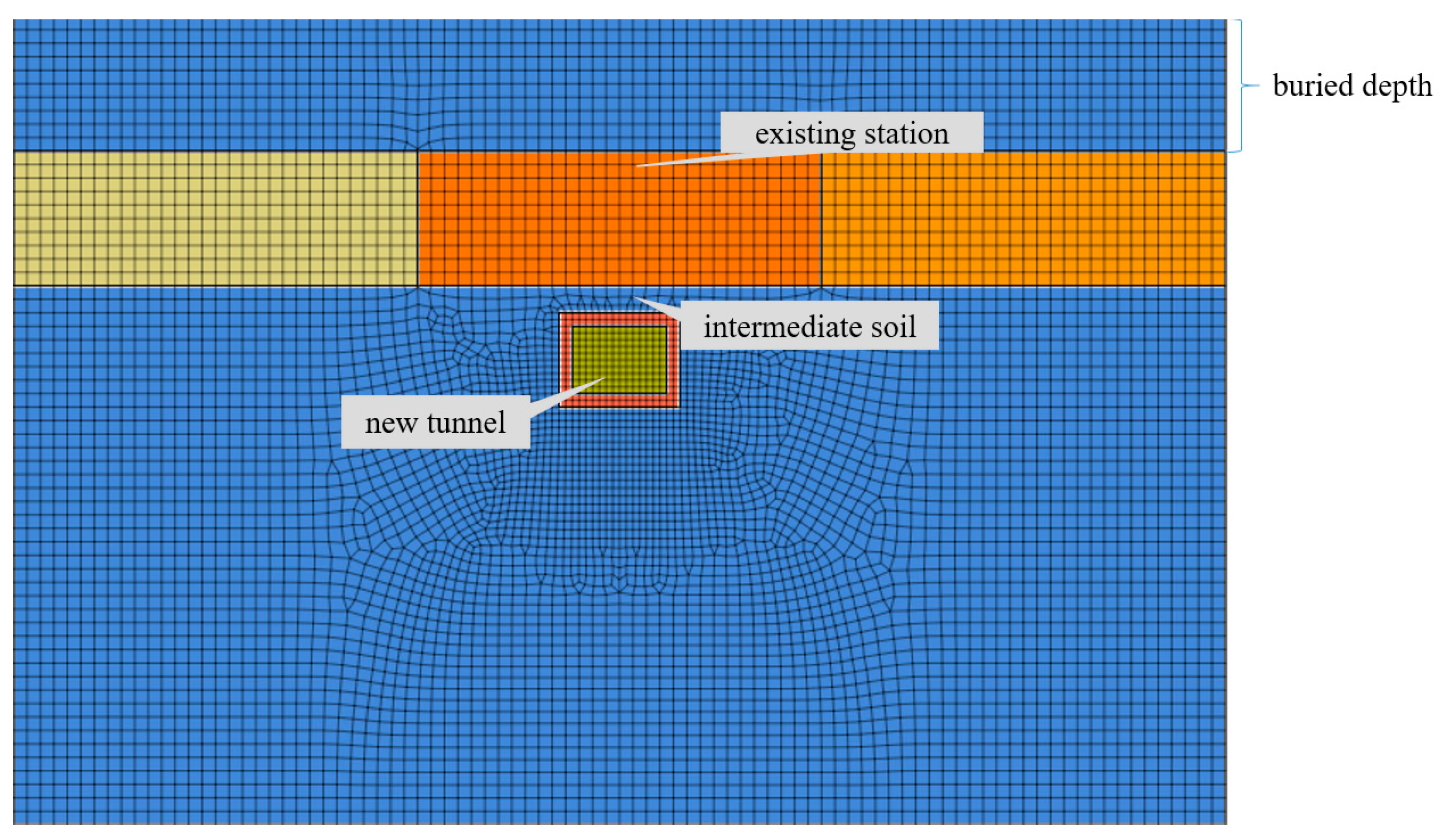
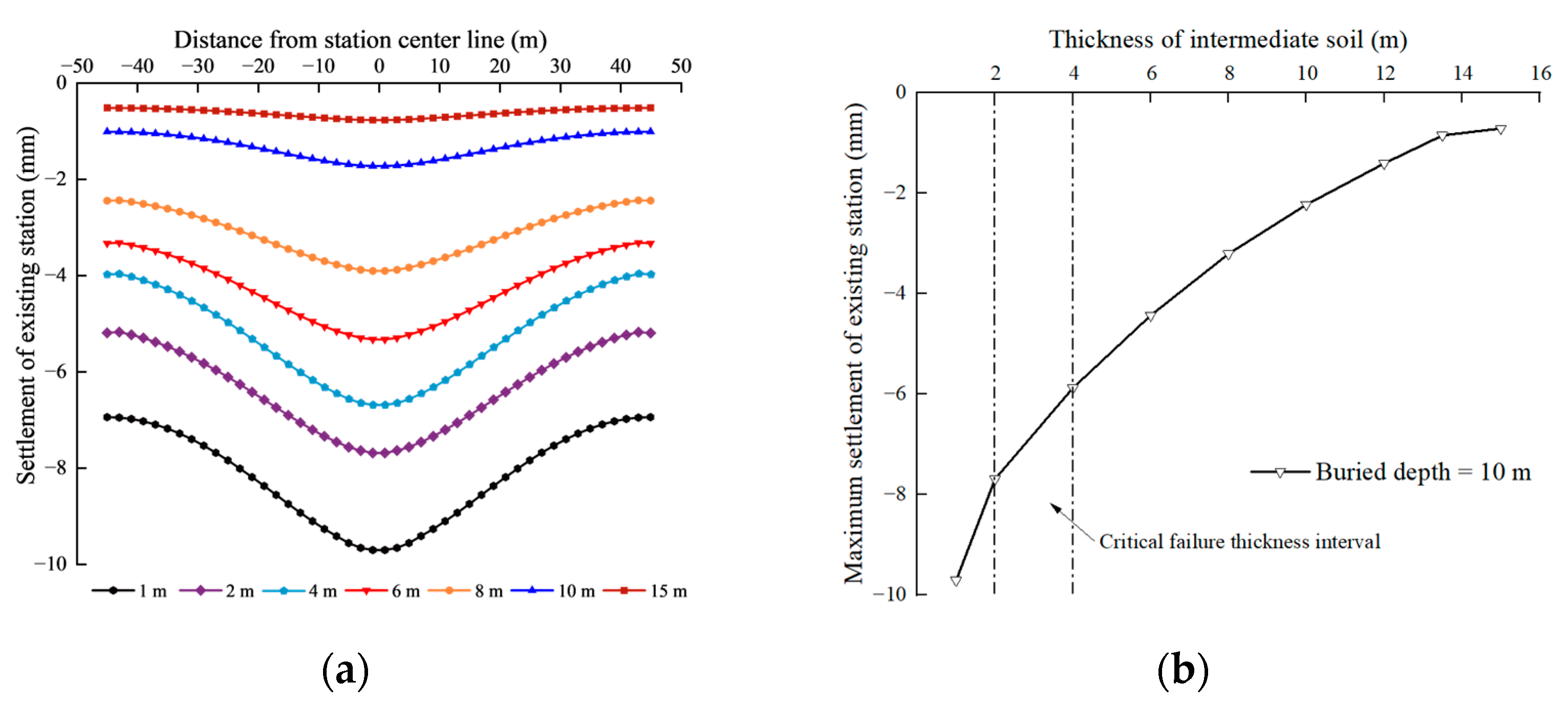
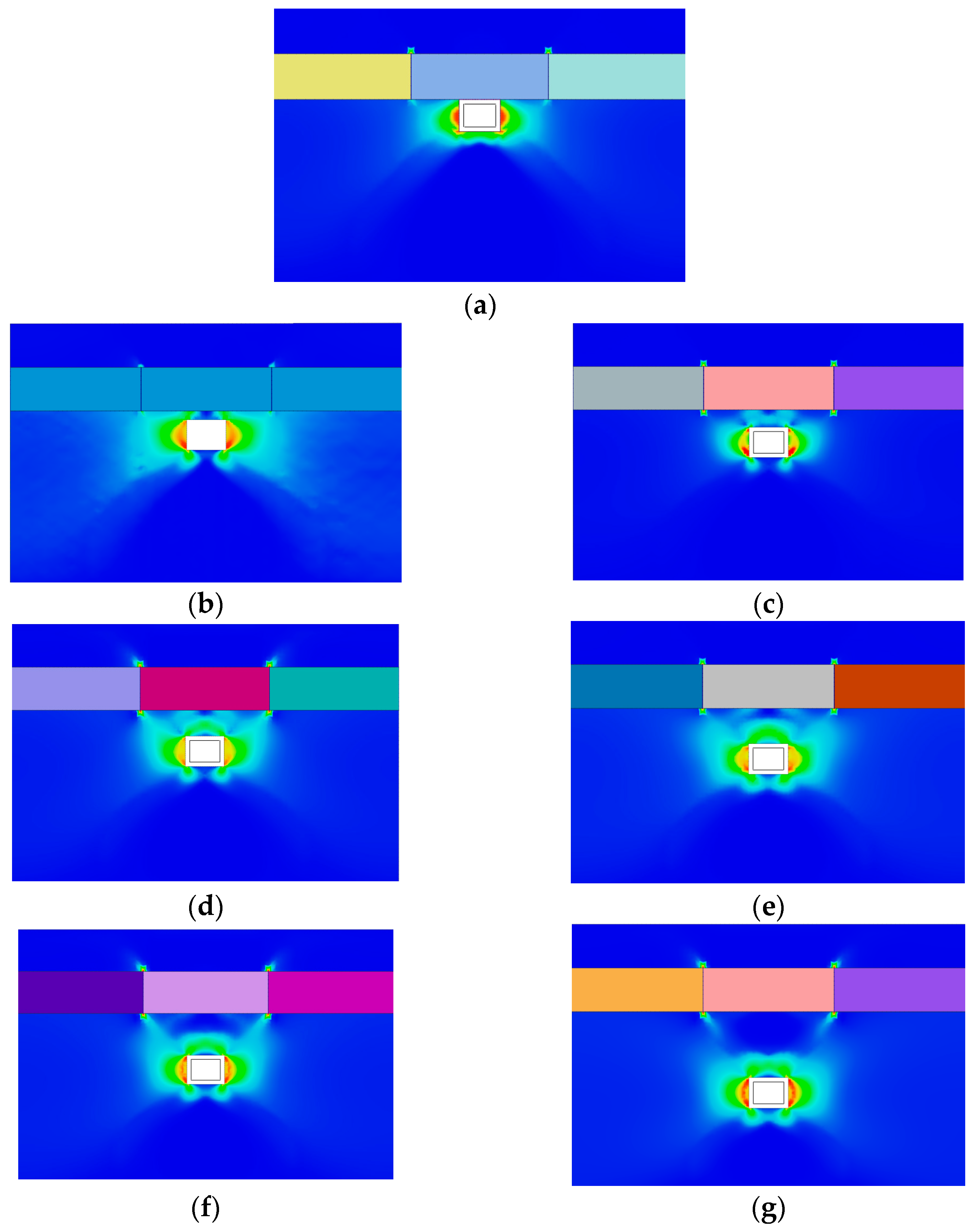
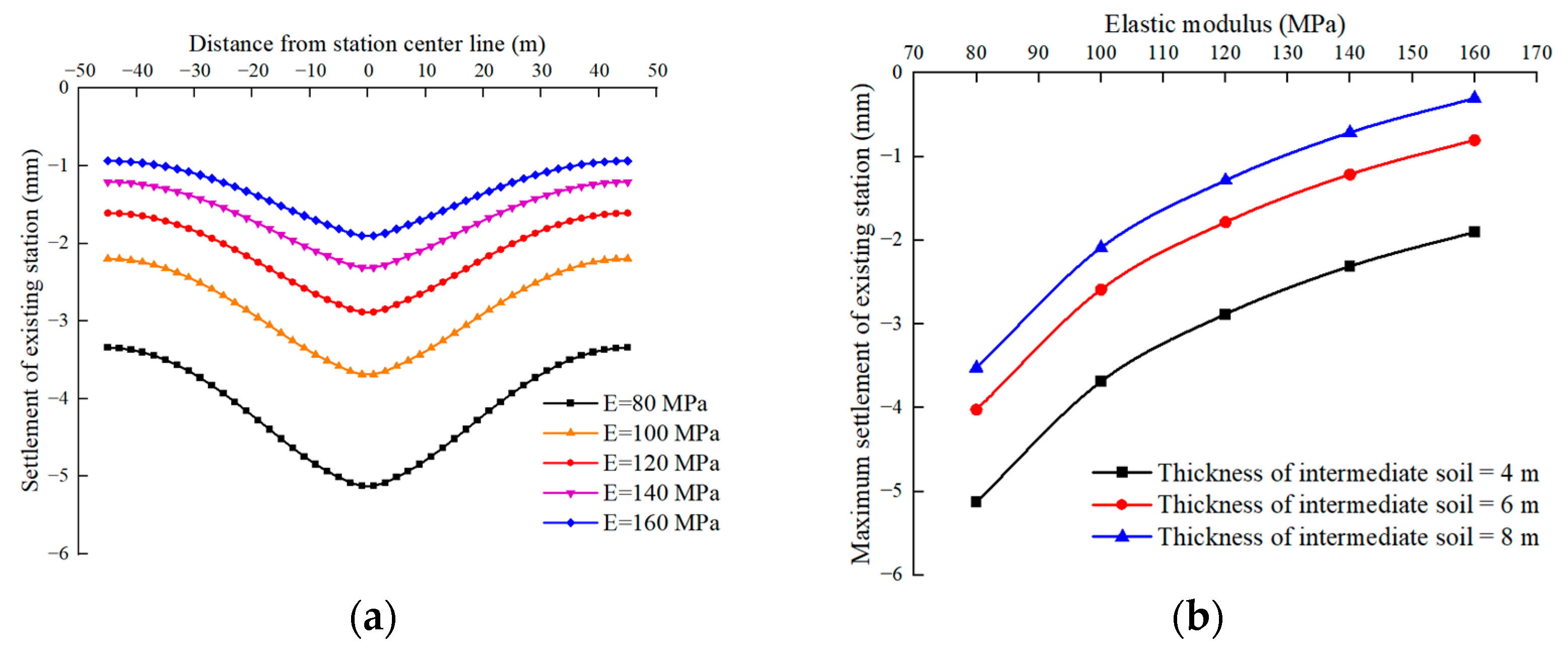

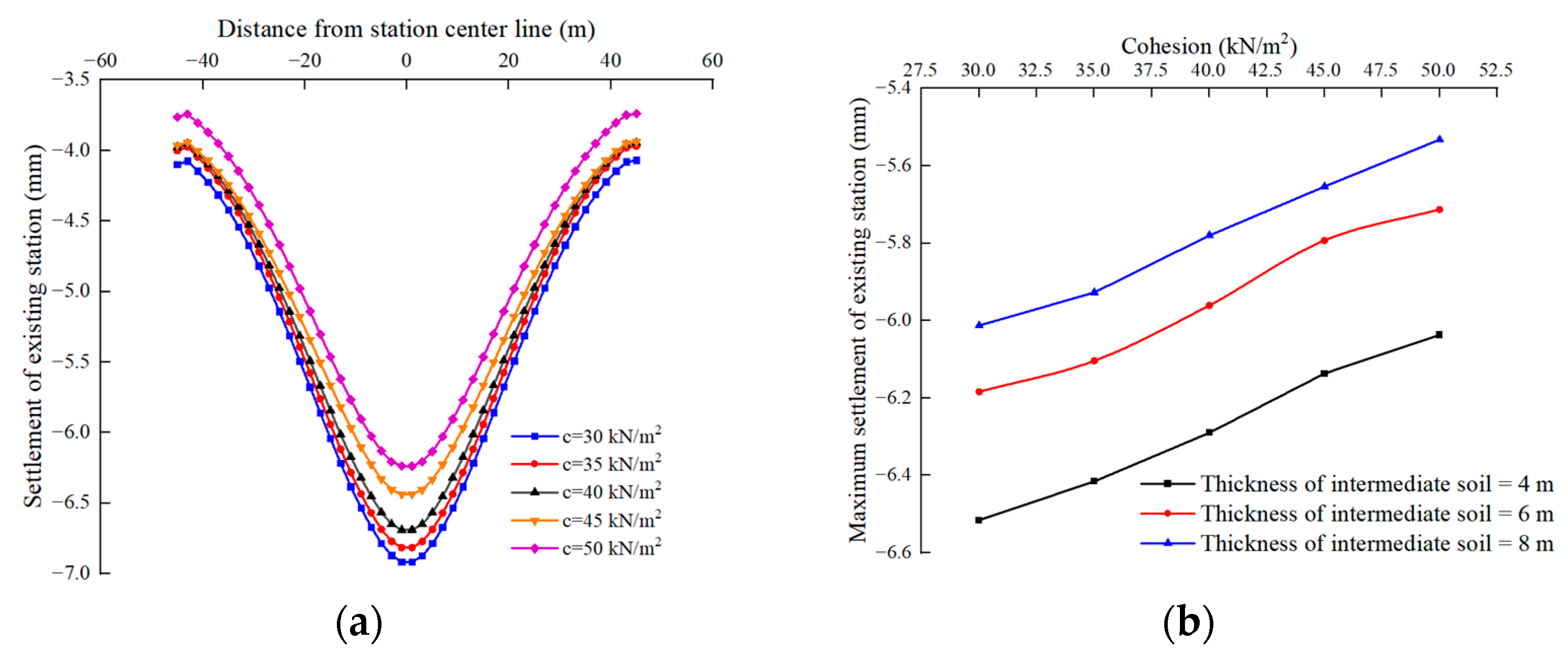

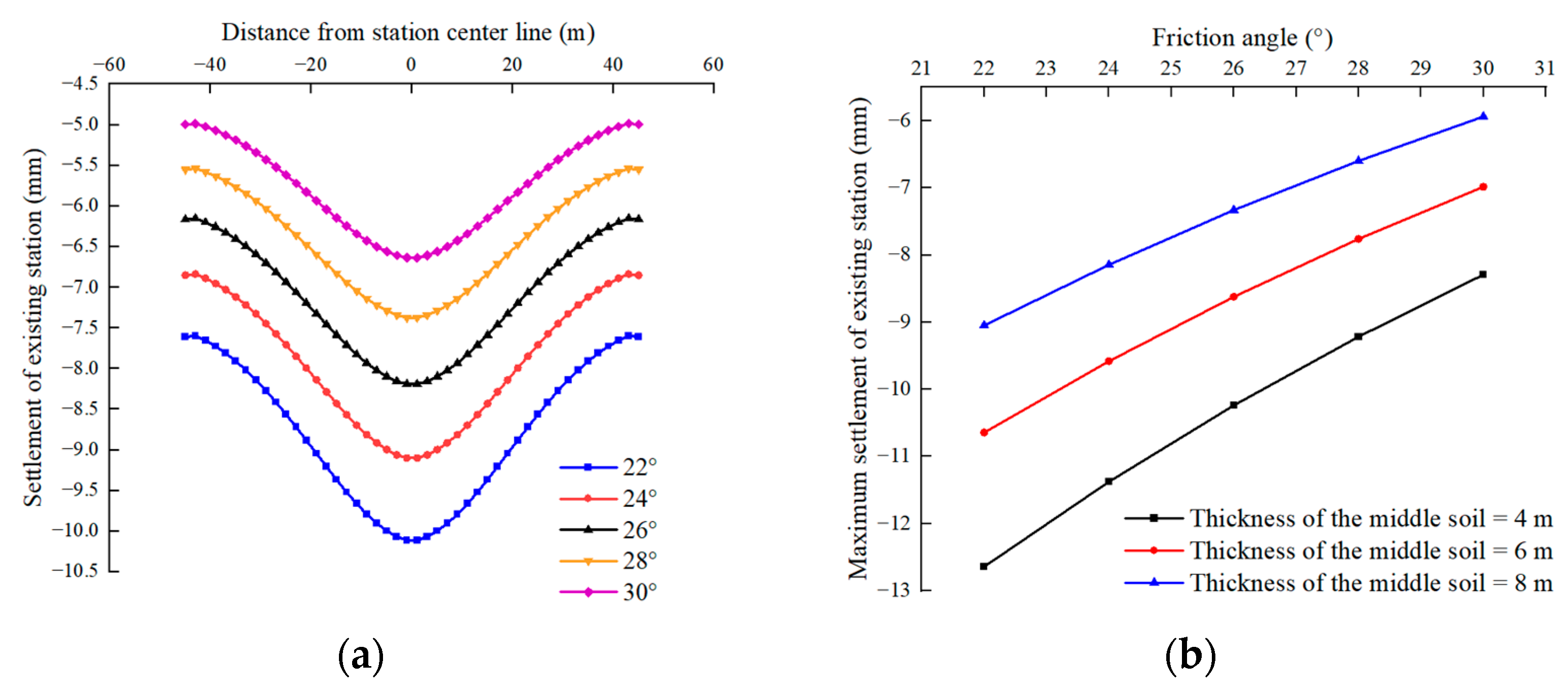

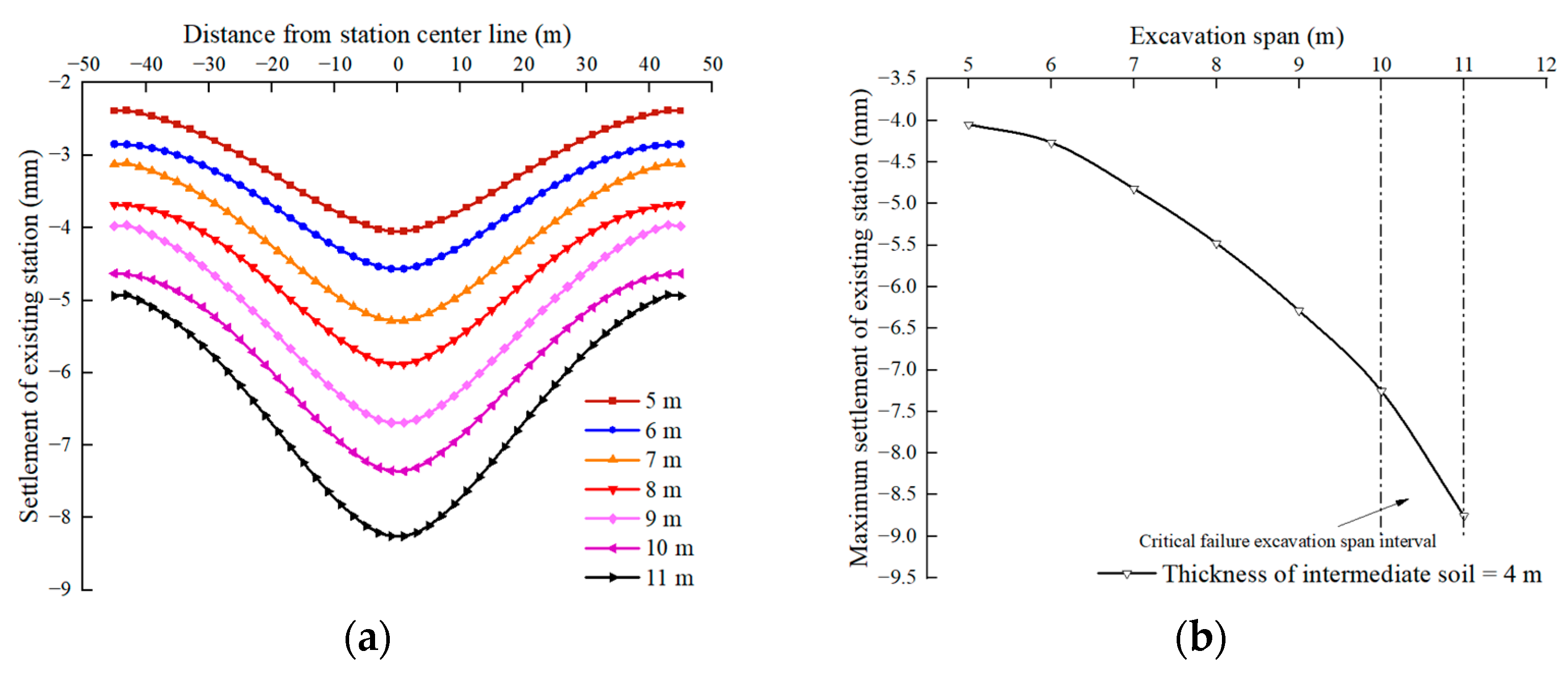
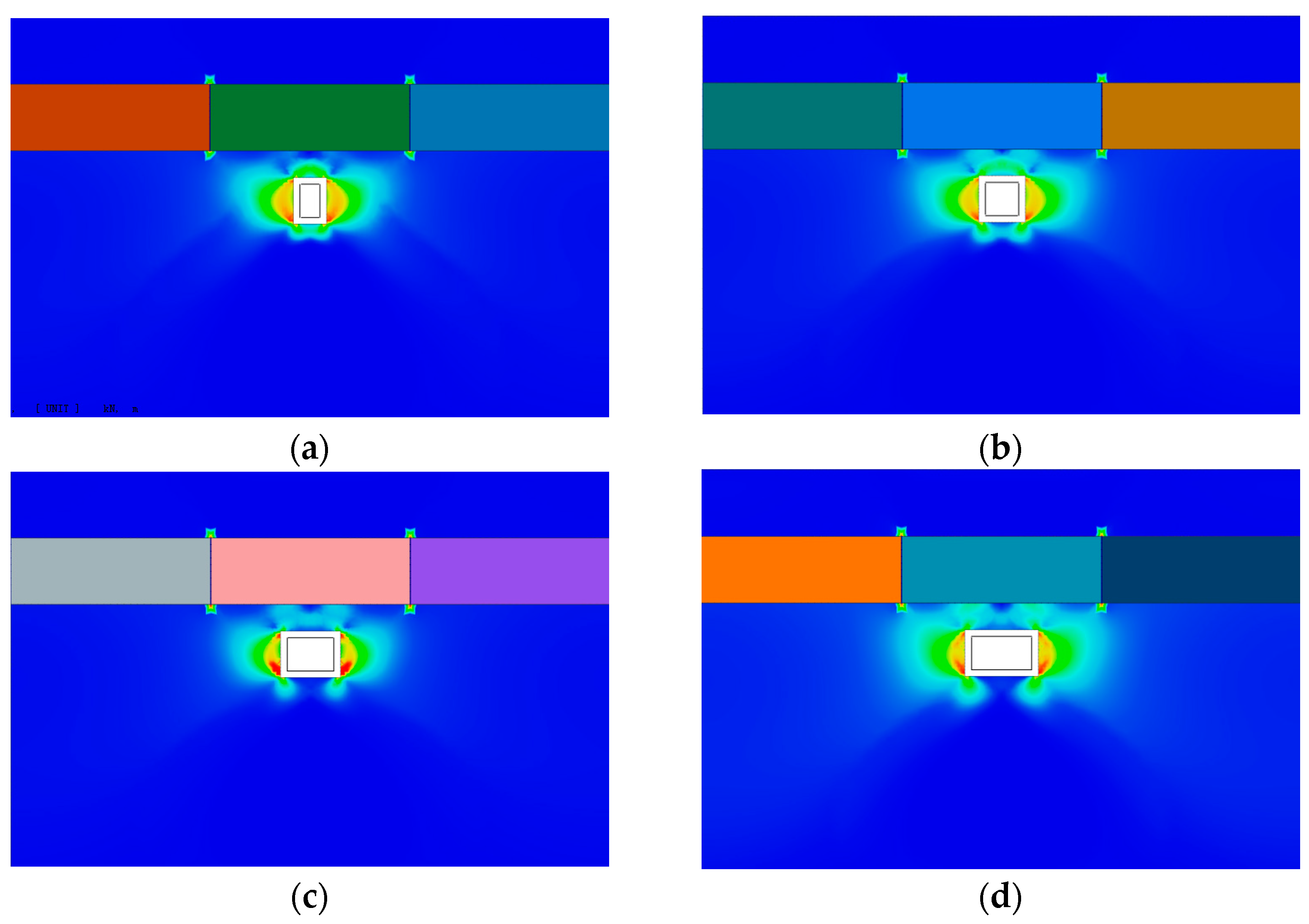
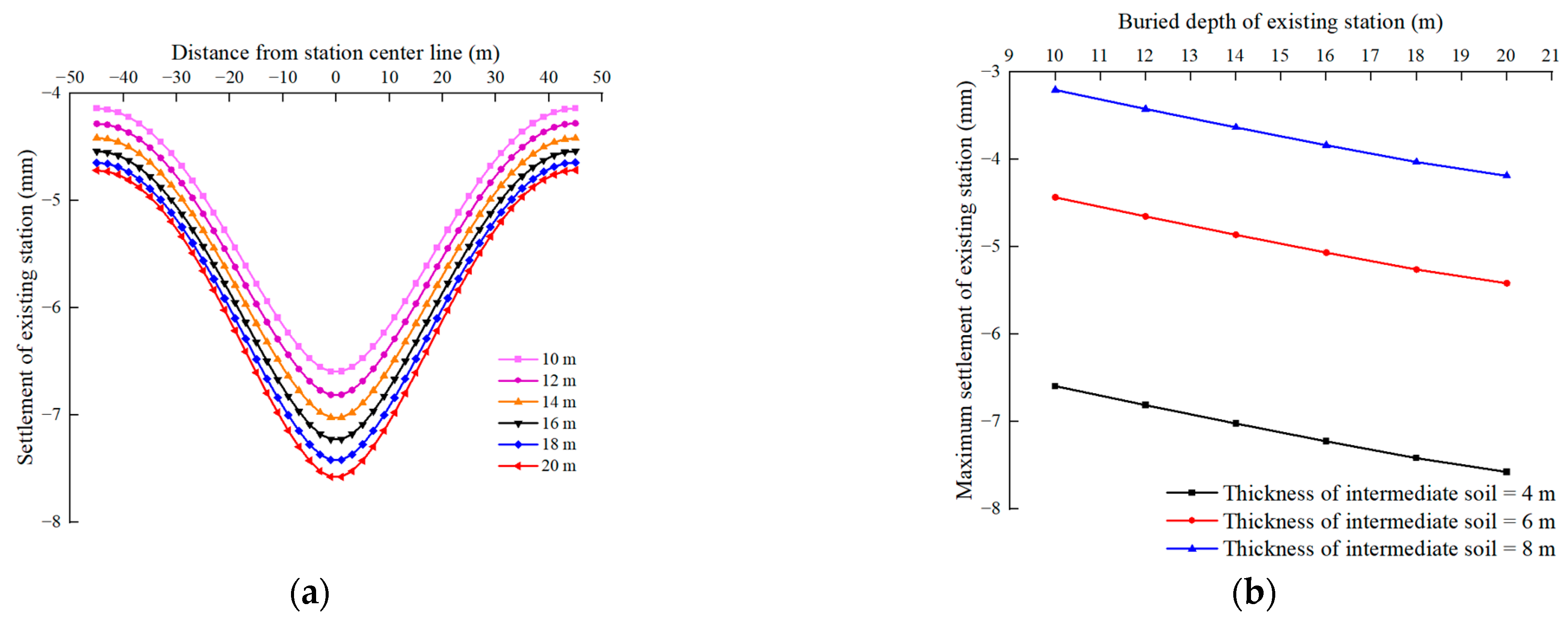
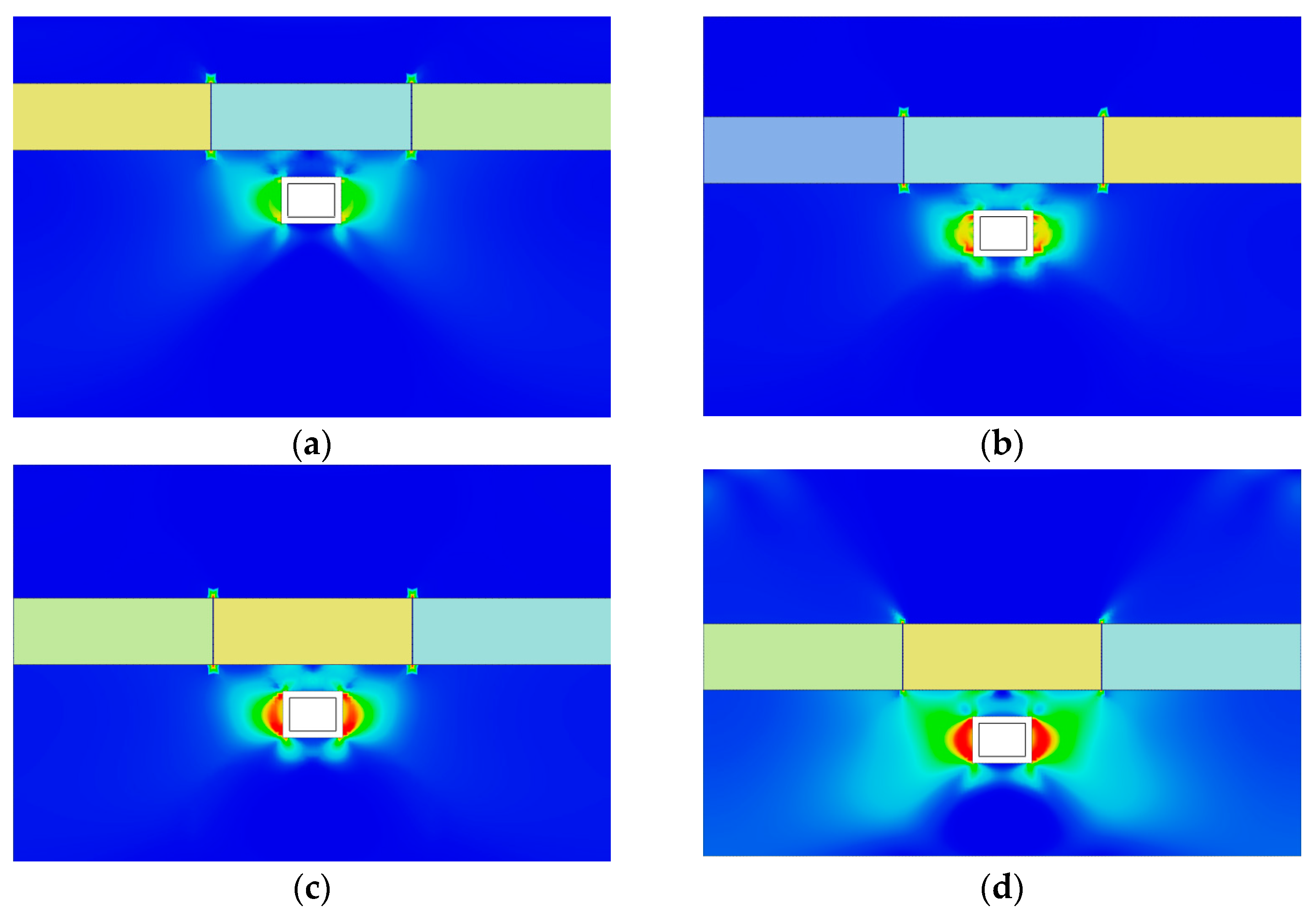
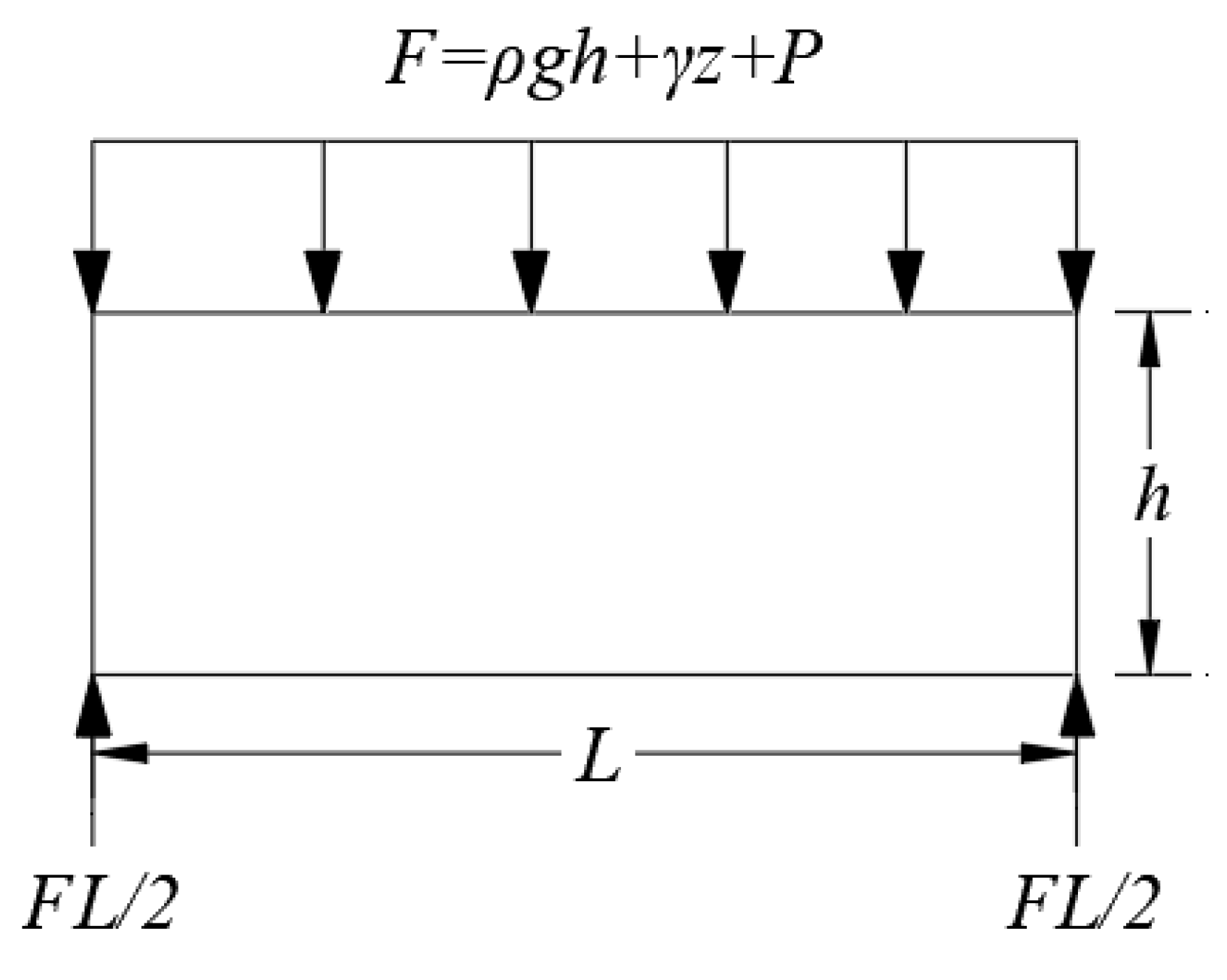
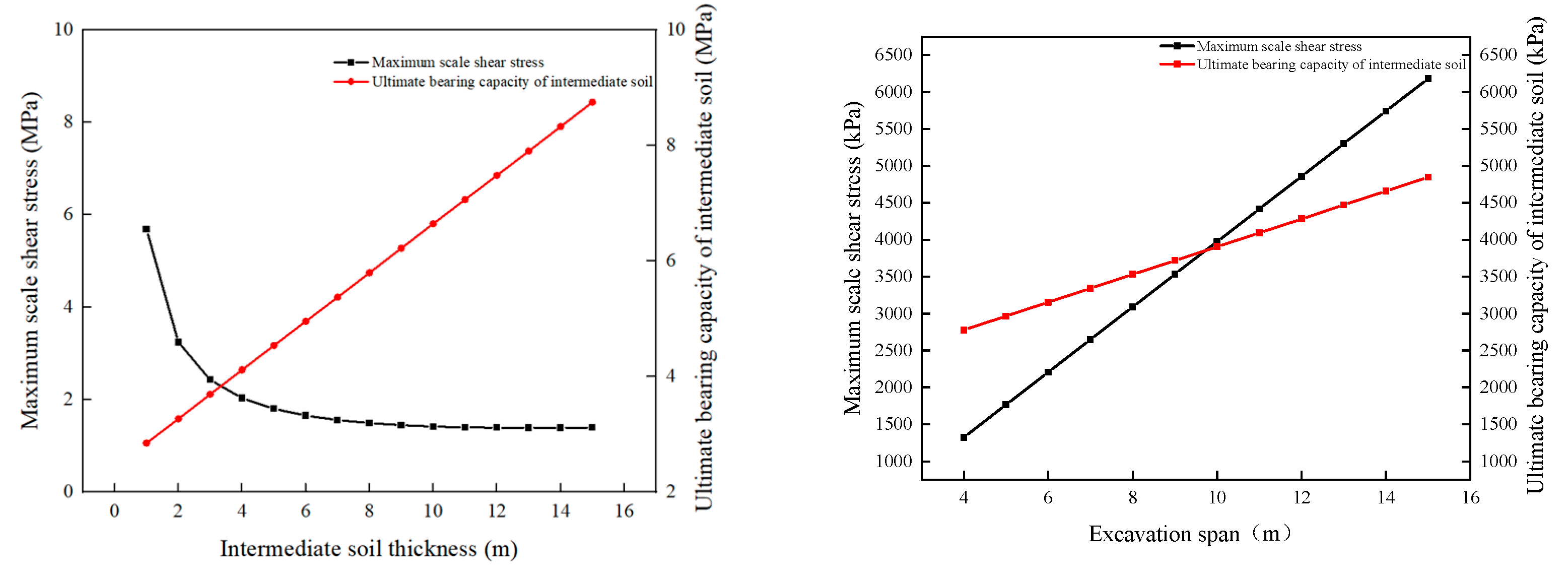
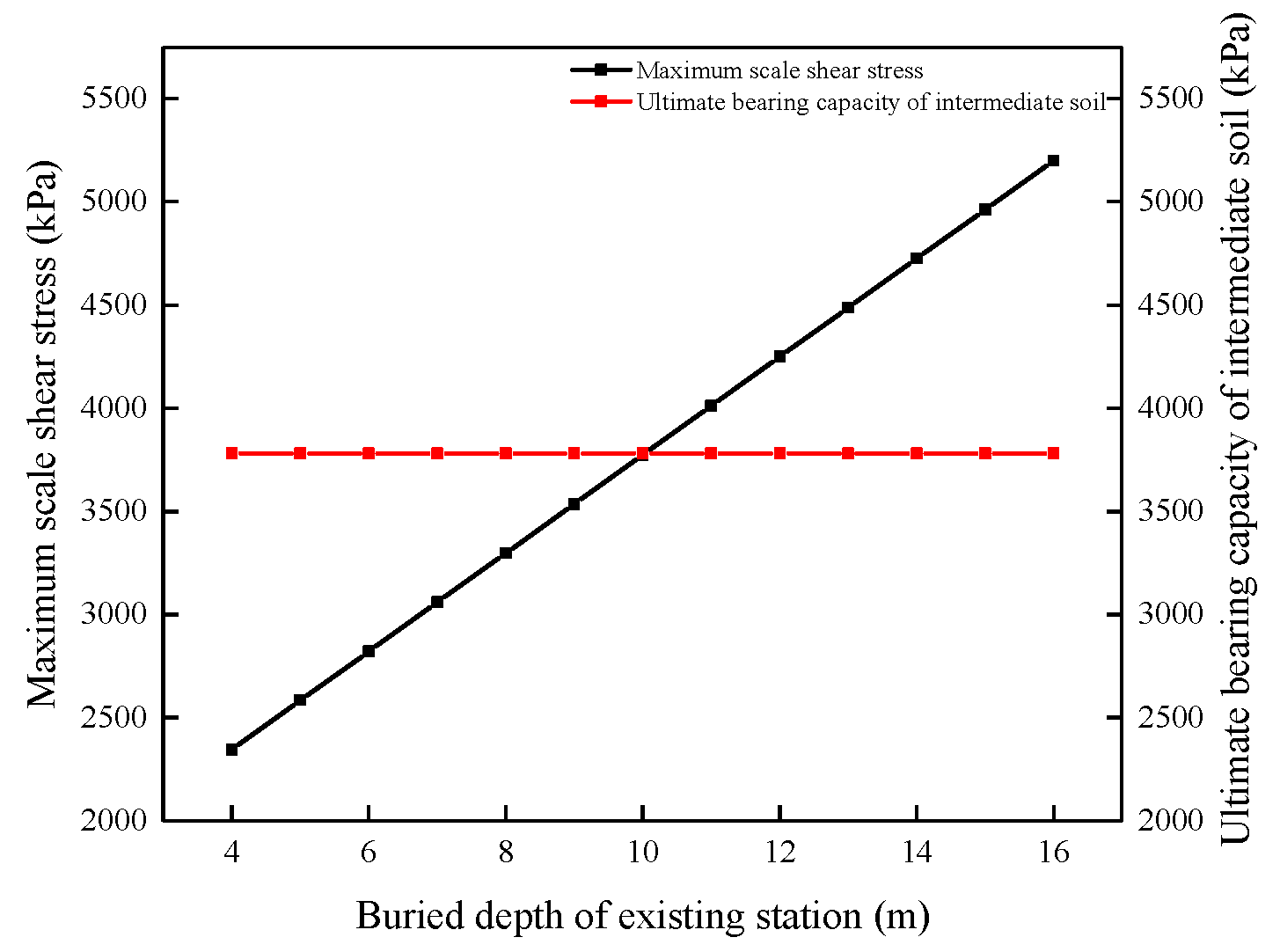
| Name | Poisson Ratio | Volumetric Weight kN/m3 | Triaxial Test Secant Stiffness kN/m2 | Tangent Stiffness of Main Compaction Loading Test kN/m2 | Unloading Elastic Modulus kN/m2 | Angle of Friction at Shear Failure | Cohesion kN/m2 | Final Expansion Angle |
|---|---|---|---|---|---|---|---|---|
| Stratum | 0.35 | 18.8 | 54,000 | 45,000 | 135,000 | 25° | 28 | 0° |
| Name | Elastic Modulus MPa | Poisson Ratio | Unit Weight kg/m3 |
|---|---|---|---|
| Primary support | 30,000 | 0.2 | 2300 |
| Secondary liner | 32,500 | 0.25 | 2500 |
| Existing station | 32,500 | 0.25 | 2500 |
| φ/(°) | Nγ | Nq | Nc |
|---|---|---|---|
| 0 | 0 | 1.0 | 5.7 |
| 10 | 1.2 | 2.7 | 9.5 |
| 20 | 5.0 | 7.4 | 17.6 |
| 30 | 20 | 22.4 | 37.0 |
| 40 | 130 | 80.5 | 94.8 |
Disclaimer/Publisher’s Note: The statements, opinions and data contained in all publications are solely those of the individual author(s) and contributor(s) and not of MDPI and/or the editor(s). MDPI and/or the editor(s) disclaim responsibility for any injury to people or property resulting from any ideas, methods, instructions or products referred to in the content. |
© 2023 by the authors. Licensee MDPI, Basel, Switzerland. This article is an open access article distributed under the terms and conditions of the Creative Commons Attribution (CC BY) license (https://creativecommons.org/licenses/by/4.0/).
Share and Cite
Wu, S.; Zhang, X.; Li, X.; Chen, J.; Liang, E.; Wu, D. Relationship between the Intermediate Soil State and Settlement Control Measures during Tunnel Construction Undercrossing the Existing Station. Buildings 2023, 13, 1933. https://doi.org/10.3390/buildings13081933
Wu S, Zhang X, Li X, Chen J, Liang E, Wu D. Relationship between the Intermediate Soil State and Settlement Control Measures during Tunnel Construction Undercrossing the Existing Station. Buildings. 2023; 13(8):1933. https://doi.org/10.3390/buildings13081933
Chicago/Turabian StyleWu, Shengzhi, Xueyu Zhang, Xiudong Li, Jian Chen, Erbin Liang, and Dun Wu. 2023. "Relationship between the Intermediate Soil State and Settlement Control Measures during Tunnel Construction Undercrossing the Existing Station" Buildings 13, no. 8: 1933. https://doi.org/10.3390/buildings13081933






